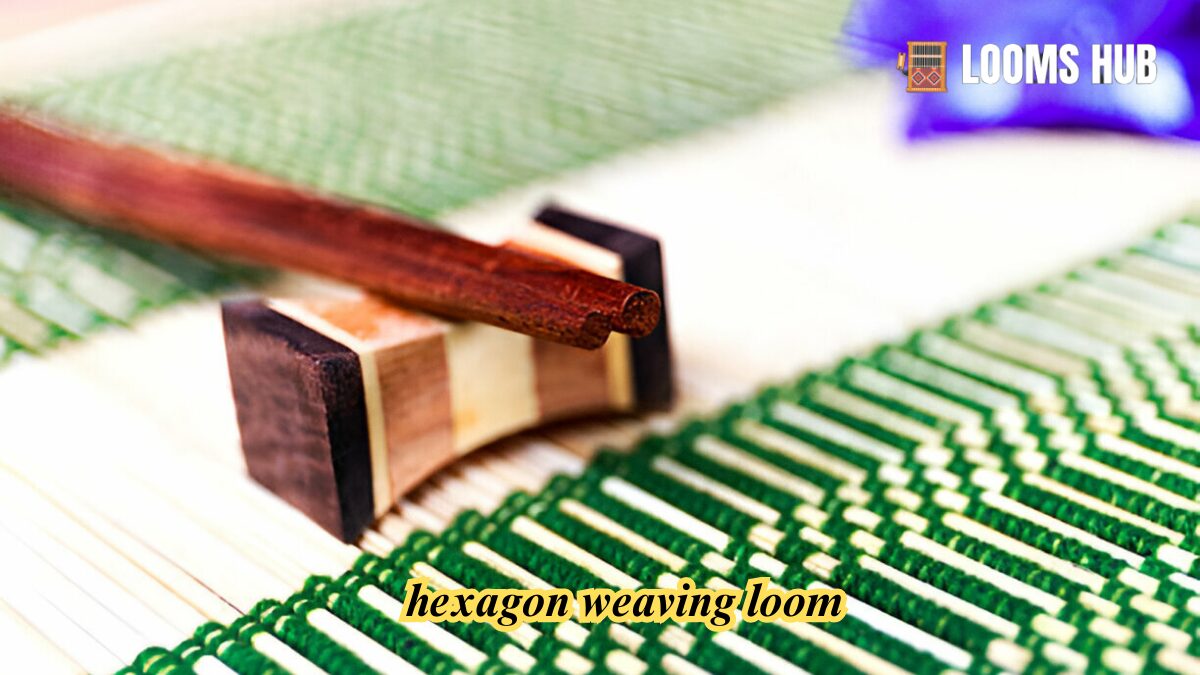Hexagon Weaving Loom:
Hexagon weaving looms offer a fascinating and creative way to craft intricate, geometric designs that aren’t possible with traditional rectangular or square looms. Whether you’re a beginner just starting out or an experienced weaver looking to try something new, the hexagon loom provides a fresh challenge and opens up endless possibilities for creating beautiful, personalized woven pieces. This guide will walk you through everything you need to know to get started with hexagon weaving looms from undersing the loom itself to mastering advanced weaving techniques. By the end of this article, you’ll not only understand how to use a hexagon loom but also have the confidence to dive into projects that will elevate your weaving skills.
What is a Hexagon Weaving Loom?
A hexagon weaving loom, as the name suggests, is a weaving tool shaped like a hexagon. Unlike the more traditional rectangular or square looms, this tool allows you to create woven designs that follow the geometry of a six-sided shape. The loom itself typically consists of pegs or nails placed along the edges of the hexagon, around which yarn or thread is wrapped and interwoven. The hexagon shape of the loom creates a unique visual appeal that lends itself well to modern, geometric patterns.
Hexagon looms can be made from various materials, including wood, plastic, and metal, each offering a different tactile experience. Wooden looms, for instance, are often favored by traditional crafters for their durability and aesthetic appeal, while plastic looms are typically lighter and more affordable, making them an excellent choice for beginners.
Key Features of Hexagon Weaving Looms:
- Shape: The six-sided design creates woven fabrics with distinctive, symmetrical patterns, making it ideal for creating modern textiles with intricate motifs.
- Materials: Commonly made from wood, plastic, or metal, each material brings a different feel and durability to the loom.
- Sizes: Available in a range of sizes, from small looms for creating compact items like coasters to larger ones for making blankets, scarves, and more.
Types of Hexagon Weaving Looms
Hexagon weaving looms come in a few different types, each offering different advantages. Whether you’re just starting out or you’re looking for something more advanced, it’s essential to choose the right loom for your project.
- Traditional Wooden Hexagon Looms Wooden looms are often handcrafted and offer a rustic, natural feel. These looms are sturdy and can stand the test of time, making them an excellent investment for furious weavers. The smooth texture of the wood provides a pleasant tactile experience while weaving, and many woodworkers enjoy personalizing their looms with designs or engravings.
- Plastic Hexagon Looms Plastic looms are often lighter and more affordable than their wooden counterparts. They are great for beginners or those who need something portable and easy to handle. Plastic looms are often brightly colored and come in a range of sizes, making them ideal for small to medium-sized projects.
- Metal Hexagon Looms Metal looms are typically more durable and long-lasting. They are often chosen for their sleek design and sturdiness, especially by crafters who want a loom that will withstand years of use. Metal looms, often made from materials like aluminum or steel, can be a bit heavier but are highly functional for large-scale projects.
Why Use a Hexagon Weaving Loom?
Hexagon weaving looms offer several distinct advantages over traditional looms. Here are some of the reasons why weavers choose to use them:
- Create Unique Geometric Patterns: The hexagonal shape enables you to create woven pieces that follow the natural geometry of the loom. This makes for beautiful, intricate, and often modern-looking textiles that aren’t achievable on square or rectangular looms.
- Versatility for Various Projects: Whether you want to weave something small like a coaster or something larger like a rug, the hexagon loom can handle both. The shape is adaptable, so it can be used for a wide range of textile projects.
- Encourage Creativity: With the freedom to experiment with colors, yarn textures, and weaving techniques, the hexagon loom allows weavers to push their creative boundaries. The final product is often a reflection of personal style, from abstract geometric designs to intricate patterns.
How to Set Up a Hexagon Weaving Loom
Setting up a hexagon weaving loom is straightforward, but like any weaving tool, it requires a little patience and understanding of the process. Here’s how to set up your loom:
- Choose Your Loom Size
- Before you start, choose a loom that fits your project needs. A smaller loom is ideal for quick projects, such as coasters or bracelets. Larger looms are better suited for creating textiles like scarves, table runners, or even blankets. The size of the loom affects both the final product’s dimensions and the complexity of the design.
- Prepare Your Yarn
- Select a yarn that matches your desired final product. If you want a soft, light piece, opt for thinner, delicate yarn. For a more substantial and durable weave, choose thicker yarn. Mix and match textures or colors to create interesting effects in your weave.
- Anchor Your Thread
- To begin, anchor your yarn at the center peg of the hexagon loom. This anchor thread will serve as the foundation for your weaving.
- Start Wrapping
- Begin wrapping the yarn around the loom’s pegs. Depending on the size of your loom and the thickness of your yarn, you may need to wrap the yarn around each peg multiple times to create a sturdy, well-structured base.
- Weaving
- Once your loom is set up, it’s time to weave! Depending on your design, you’ll move the yarn over and under the pegs in a specific pattern. This process will form the weave and produce the final textile.
Techniques for Weaving on a Hexagon Loom
Weaving on a hexagon loom can be as simple or as complex as you desire. There are several techniques to explore, each offering its own set of advantages and challenges. Here’s a breakdown of the most common techniques:
- Basic Weaving This is the most fundamental technique where you pass the yarn over and under the pegs, following a simple back-and-forth pattern. This technique is perfect for beginners, allowing you to get the hang of how the loom works before moving on to more complex designs.
- Double Weaving Double weaving involves using two different threads simultaneously. This technique produces a thicker, more durable fabric, perfect for items like bags, pillows, or blankets.
- Tapestry Weaving Tapestry weaving is a more advanced technique that allows you to create intricate patterns and designs using different colors, textures, and yarn types. This technique is perfect for making pieces that incorporate both geometric designs and artistic motifs.
- Honeycomb Weaving One of the most popular techniques for hexagon looms, honeycomb weaving utilizes the loom’s natural shape to create a honeycomb-like pattern. This method adds texture and depth to your fabric, making it a great choice for creating statement pieces.
Hexagon Loom Projects: Ideas and Inspiration
The hexagon loom is incredibly versatile, and there are countless projects you can create. Here are some ideas to get you started:
- Coasters and Placemats: Hexagon coasters are a great beginner project, and they’re functional too. You can make sets of coasters or even larger placemats by weaving multiple hexagons together. Play with yarn color combinations to match your home decor.
- Rugs and Wall Hangings: For a larger project, consider weaving a rug or wall hanging using several hexagon-shaped woven pieces. These can add a modern, geometric touch to any room.
- Scarves and Shawls: Hexagons can be woven together to create a larger piece of fabric for scarves or shawls. These projects often require advanced techniques, but the results are stunning and unique.
- Tote Bags and Pouches: Use your hexagon weaving skills to create fashionable accessories like tote bags or pouches. The sturdy nature of the hexagon weave lends itself well to making items that need durability, such as bags.
Troubleshooting Common Issues with Hexagon Weaving Looms
As with any crafting tool, you might encounter a few issues along the way. Here’s how to troubleshoot some common problems:
- Warp Threads Getting Tangled: To prevent tangling, keep your yarn organized. Use thread spools or bobbins to store your yarn before starting to weave.
- Uneven Tension: If your weave looks uneven, the tension on your yarn might be too tight or too loose. Make sure you’re applying a consistent amount of tension as you weave to keep the rows even.
- Fraying Edges: To avoid frayed edges, secure the beginning and end of each row properly by knotting the yarn or weaving the end back into the piece. This will keep the fabric from coming undone.
Caring for Your Hexagon Weaving Loom
Taking care of your loom will ensure that it lasts for many years. Here are a few tips:
- Clean Your Loom Regularly: Dust and debris can accumulate on your loom, so make sure to wipe it down regularly with a soft cloth. If it’s a wooden loom, avoid using harsh chemicals that might damage the surface.
- Check for Wear and Tear: If your loom has pegs, check them for any signs of wear. Over time, pegs might become loose or damaged. Tighten them before starting any new project.
- Store Properly: When not in use, store your
loom in a dry, cool place to prevent warping, especially if it’s made of wood. A sturdy bag or box is ideal for protecting it from dust and accidental damage.
Conclusion
Hexagon weaving looms are a fantastic addition to any weaver’s toolkit. They offer a unique way to create geometric and textured patterns that would be difficult to achieve on traditional square or rectangular looms. With a little practice and patience, you can use these looms to create stunning textiles, from coasters and scarves to rugs and bags. Whether you’re a beginner or an experienced weaver, there’s always something new to explore with the hexagon loom.
FAQs
Can I use knitting yarn for hexagon weaving?
Yes! Knitting yarn is an excellent choice for hexagon weaving. Just make sure to choose a yarn that is appropriate for your project thicker yarn for dense fabrics, thinner yarn for delicate textures.
How long does it take to make a hexagon rug?
Creating a hexagon rug can take anywhere from a few hours to several days, depending on the size and complexity of the design. Larger rugs may require more time and effort, but the results are worth it.
Can I combine hexagons with other shapes?
Absolutely! You can combine hexagons with other shapes like squares or triangles to create more complex patterns and designs. The flexibility of the loom allows you to experiment with different shapes and patterns to create truly unique pieces.



